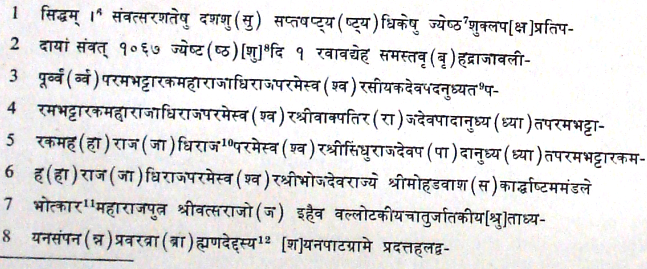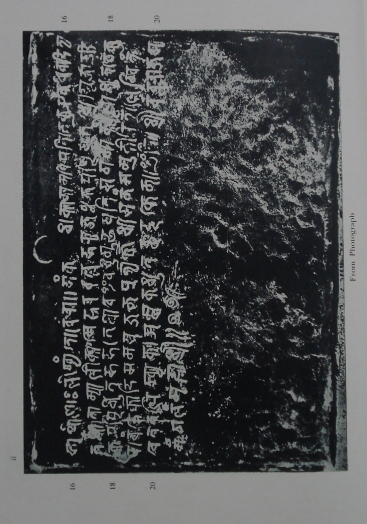|
The Indian Analyst
|
North Indian Inscriptions |
INSCRIPTIONS OF THE PARAMARAS OF MALWA the present inscription teems not only with grammatical but also with scribal errors, the only alternative that we can think of is that the word is to be taken in the sense of bhōktṛi, which assumed the form bhōktāra due to error on the part of the composer of the record and is engraved as bhōtkāra, wrongly, by the scribe or may have been so written by the writer. ...The only Vatsarāja who is known to us as flourishing in the period in question was a prince belonging to the Chālukya house, a son of Kīrttirāja and a great-grandson of Bārappā, the founder of the Chālukya house of Lāṭa. Kīrttirāja, who issued a grant on the Tāptī in Śaka 940 or 1018 A.C.,[1] was a contemporary of the Paramāra Bhōja ; and, in view of this, Vatsarāja of the present record appears to be the homonymous prince, i.e. a son of Kīrttirāja ; and it is not improbable that he was enjoying the said region where the inscription under study has been discovered, and may have been a feudatory of Bhōja,[2] who was then aggrendising himself at the cost of his inveterate enemy, the Chaulukya Mūlarāja, whose inscriptions are all found to the west of the Sābarmatī, in the region bordering to that of the Paramāra kingdom. It is true that the name of Vatsarāja’s father is not mentioned in the present record ; but we have a number of similar instances, e.g. those of Mahārājaputra Ajayapāla and Rājaputra Vaddiga in the Bhopāl pillar inscription of Mahākumāra Lakshmīvarman, as we shall see below (No. 41). It also appears that mahārājaputr[3] was a title in those days, resembling Rājaputra (Rājpūt), rāṇaka and mahārāṇaka, and need not be taken strictly to denote a prince. ...Fortunately all the geographical names mentioned in the inscription can be identified with confidence. Mōhaḍavāsaka (1. 6), as seen above, is Mōḍāsā, the headquarters of a parganā of the same name in the Sābarkāṇṭhā District. Śayanapāṭaka, the village where the grant was made (1.8), is evidently the modern Shenvāḍ, lying about 10 kms. north of Mōḍāsā, and it is interesting to note here that the plates were found in a neighbouring village of the name of Kōkāpur. Harshapura of the inscription (1.11) appears to be identical with Harsōlā, the find-spot of the plates issued by Sīyaka, as seen above. This place is about 30 kms. south by west of Mōḍāsā, and its situation in Gujarāt favours this view, though, as suggested by similarity in names, its identifica- tion with Harsaudā where Dēvapāla’s stone inscription was found[4] , cannot altogether be precluded. The expression Vallōṭaka (1.7) may perhaps have been a locality, the original place of the Valloṭakīya Brāhmaṇas mentioned in the inscription. But we have no clue to identify this place.
TEXT[5]
[1] D.R. Bhandarkar’s List, No. 1088.
|
||||||||||||||||||||||||||||||||||||||||||||||||||||||||||||||||||||||||||||||||||||||
| > |
|
>
|










